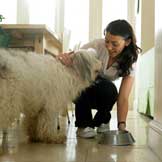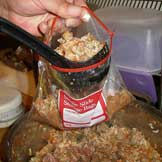
If you follow nutrition closely, you may have noticed a difference in the way in which nutrient recommendations are typically made for people and pets. You’ll often hear the term “recommended daily allowance (RDA)” thrown around for people, as in “the RDA for protein for women over the age of 18 is 46 grams.” On the other hand, veterinarians and owners tend to talk more about minimum and maximum percentages. Ever wonder why?
That’s the way that the guaranteed analysis on a pet food label is presented and the way in which the AAFCO (Association of American Feed Control Officials) Nutrient Requirements are printed, so it’s pretty much the only readily accessible information we have available.
But when you think about it, a minimum or maximum value doesn’t really give you all that much information. The minimum amount of protein that an adult maintenance dog food can contain and still fit AAFCO guidelines is 18 percent. Okay, so I obviously don’t want to feed a food that contains 14 percent protein, but is 18 percent ideal, or is 25 percent better? How about 35 percent or 55 percent?
You get the idea. What I really want to know are the RDAs for important nutrients in dogs.
That information is available in the form of the National Research Council (NRC) Nutrient Requirements tables, which were last updated in 2006. The data is written in the form of number of grams (g) of a particular nutrient per 1,000 kcal metabolizable energy (ME) of a food.
For example, the NRC recommended allowance for protein in adult dogs is 25 g/1,000 kcal ME. The recommended allowance (RA) for fat is 13.8 g/1,000 kcal ME. The numbers for puppies after weaning are 56.3 g protein/1,000 kcal ME and 21.3 g fat/1,000 kcal ME.
For the cat people out there, the RAs for protein are 50 g/1,000 kcal ME and 56.3 g/1,000 kcal ME for adults and kittens respectively, and for fat it is 22.5 g/1,000 kcal ME, regardless of age.
Now remember, these aren’t percentages that can be compared to the information provided on a pet food label. Lines like this — Calories: (ME) 4191 kcal/kg, 1905 kcal/lb, 470 kcal/cup — do appear on bags, cans, and websites, and the guaranteed analysis might tell us that a food has a minimum protein percentage of 28 and a maximum moisture content of 10 percent, but I don’t see a straightforward way to use this information to determine if a food meets the NRC recommended allowances. I’ve filled a page with scribbles and given myself a headache trying.
The NRC tables provide a whole lot more data than just protein and fat RAs. They get into specific amino acids, types of fatty acids, minerals, and vitamins. The information might be valuable to owners and veterinarians, if we had a way to compare it to what we do know about pet foods.
Until then, we’ll have to rely on minimum and maximum percentages. They may not give us all the information we want, but at least they’re in a form we can use.

Dr. Jennifer Coates
Image: Thinkstock









